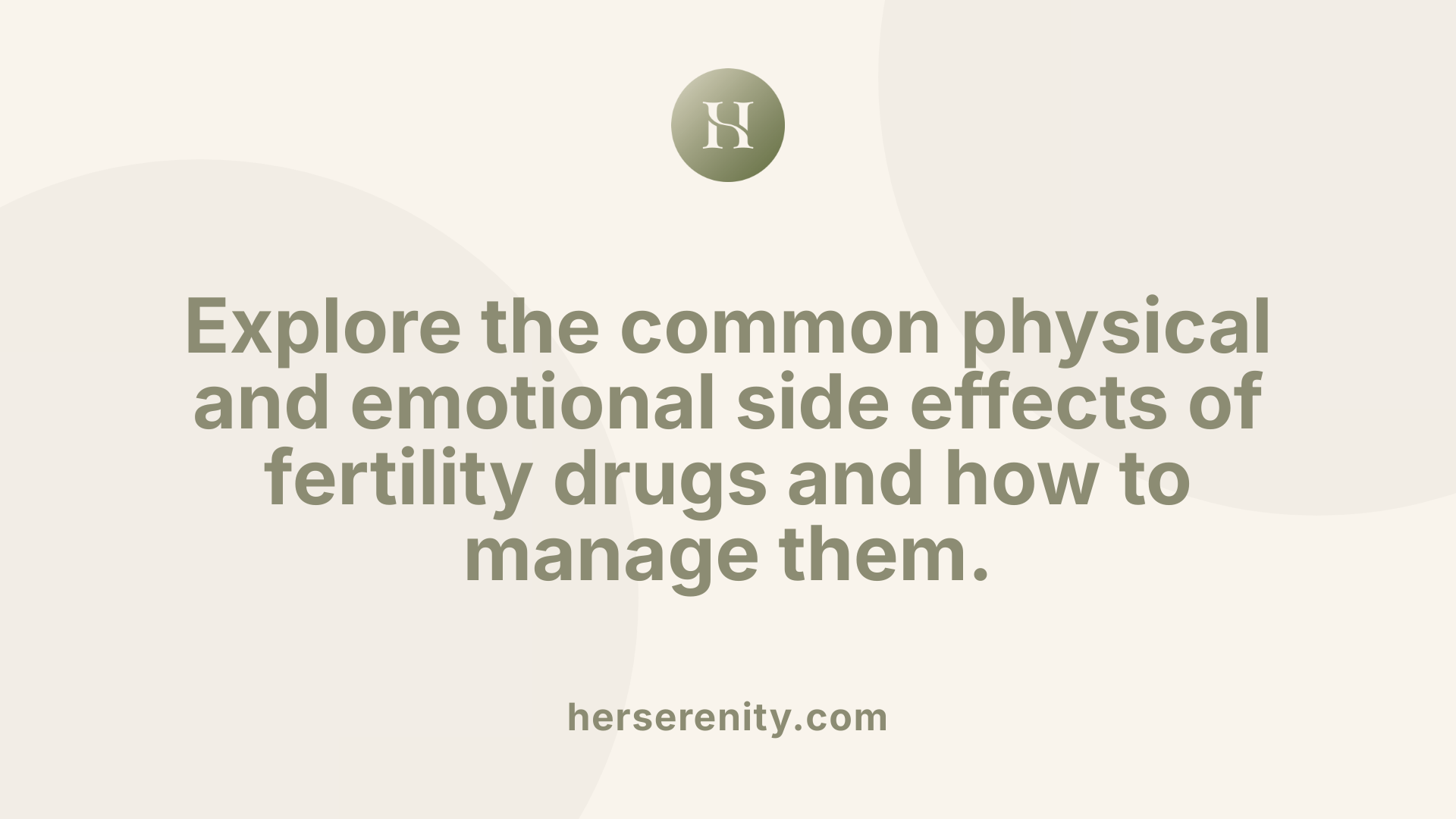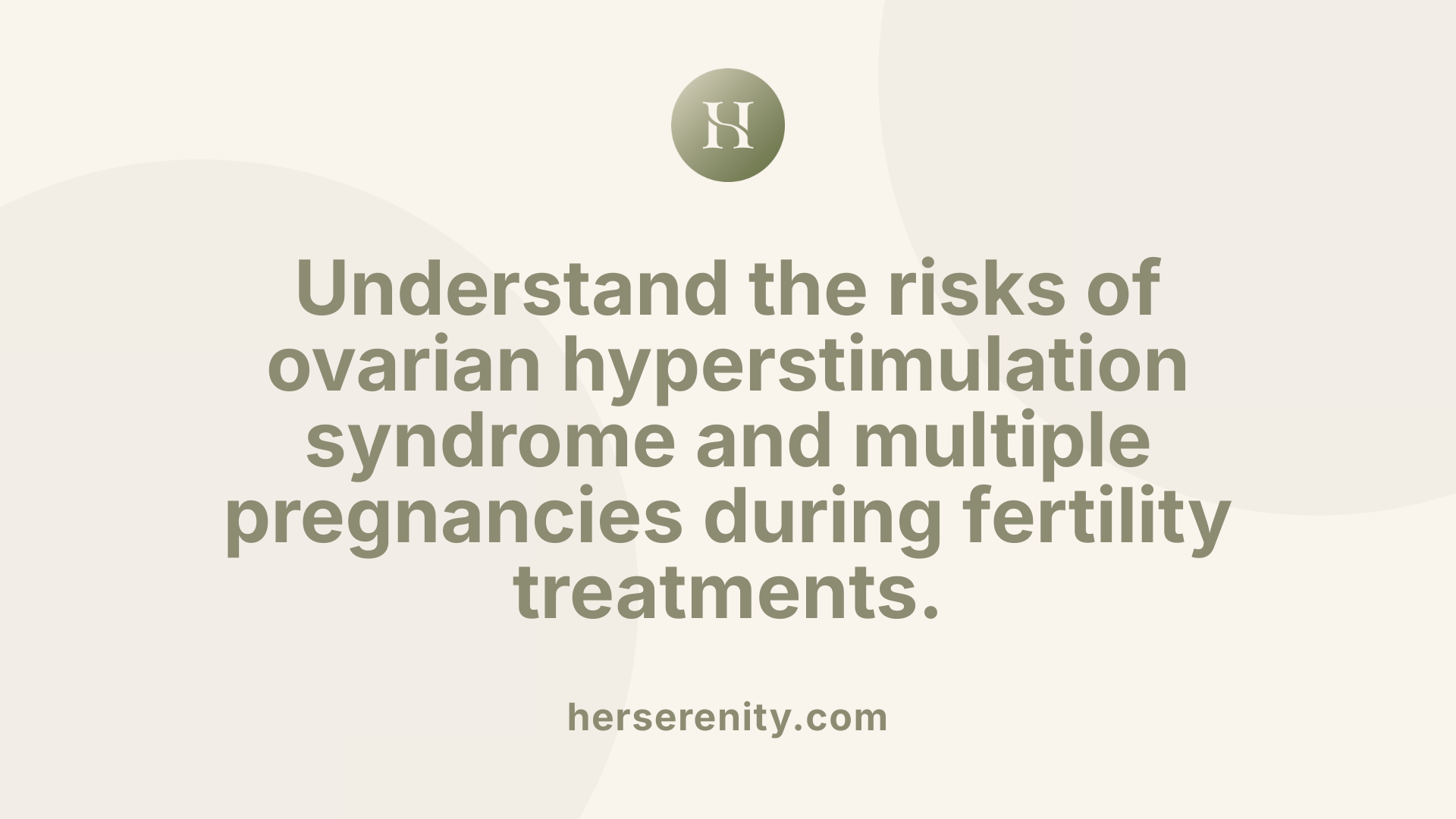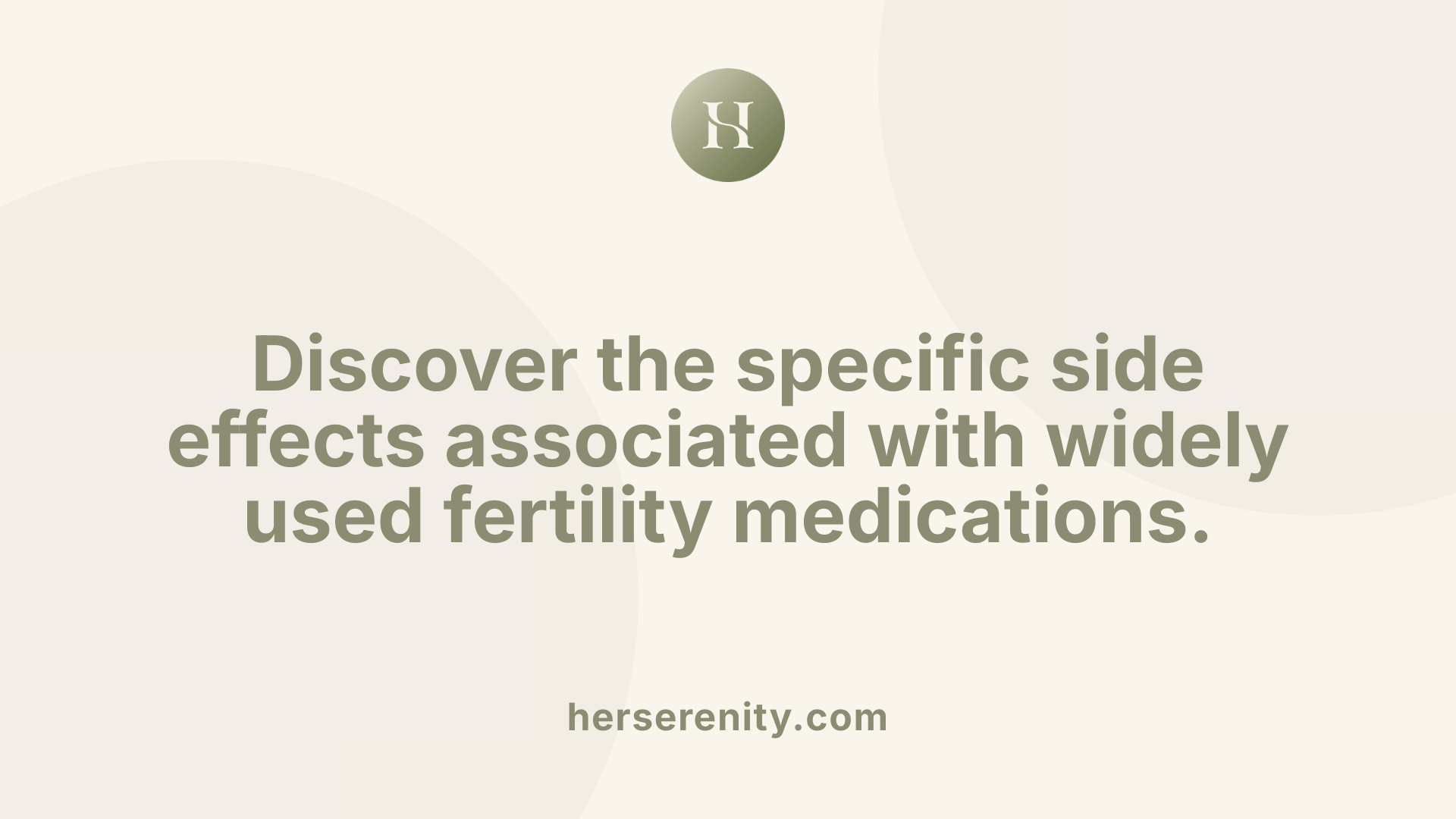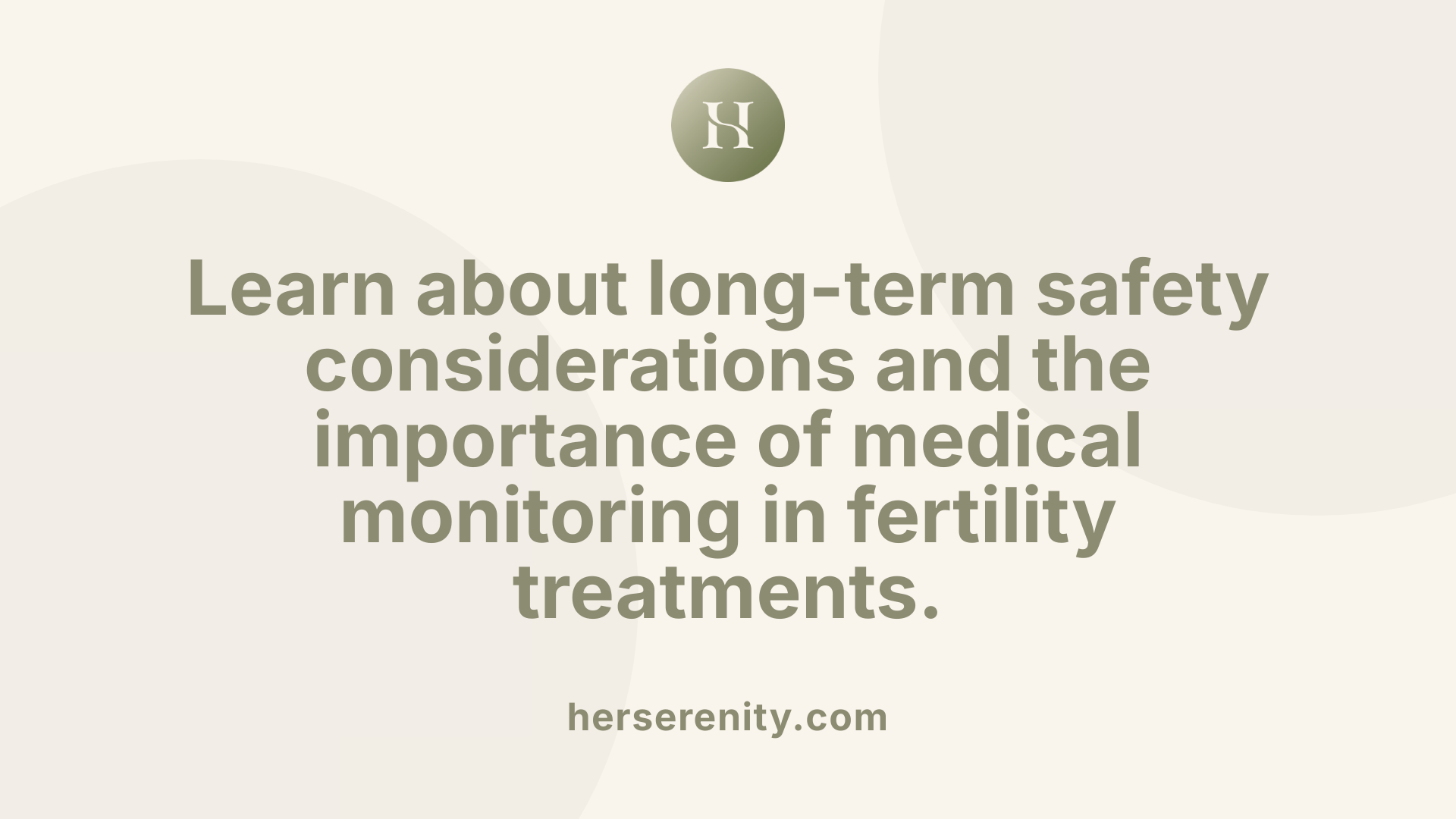Common side effects of fertility medications
Understanding the Risks and Common Side Effects of Fertility Medications

Introduction to Fertility Medications and Their Side Effects
Fertility medications play a crucial role in assisting many individuals and couples to conceive. These drugs, designed to promote hormone production and regulate chemical levels, are integral to treatments such as in vitro fertilization (IVF) and intrauterine insemination (IUI). While these medications significantly enhance fertility prospects, they are associated with a spectrum of side effects, ranging from mild temporary symptoms to serious health risks. Understanding these common adverse effects, potential complications, and safety considerations is vital for anyone undergoing fertility treatment.
Common Physical and Mood-Related Side Effects of Fertility Medications
 Fertility medications are vital tools used to increase the chances of conception by promoting hormone production and balancing chemical levels. However, many women experience side effects, especially those involving physical discomfort and mood changes.
Fertility medications are vital tools used to increase the chances of conception by promoting hormone production and balancing chemical levels. However, many women experience side effects, especially those involving physical discomfort and mood changes.
The most common physical side effects include headaches, nausea, bloating, and hot flashes. Some women also report blurry vision, breast tenderness, and abdominal or pelvic discomfort. For medications like clomifene, visual disturbances and abnormalities in cervical mucus can occur, along with luteal phase deficiency.
Mood-related side effects are also prevalent. These include mood swings, irritability, anxiety, and depression. Such emotional changes are often linked to hormone fluctuations caused by fertility drugs.
Injections of gonadotropins or pulsatile GnRH therapy can, in some cases, lead to ovarian hyperstimulation syndrome (OHSS). This condition ranges from mild symptoms like abdominal bloating and discomfort to severe cases with swelling, breathing difficulties, and even life-threatening complications.
Women undergoing fertility treatments should be aware of these potential side effects. Mild symptoms generally resolve on their own or with simple management strategies. But if symptoms worsen or new concerns develop — such as severe pain, significant swelling, or vision changes — immediate medical attention is required.
Risks associated with fertility medications also include multiple pregnancies and a slightly increased chance of pregnancy loss. Though research is ongoing, some studies suggest potential links to ovarian or endometrial cancers, emphasizing the importance of monitoring and medical oversight.
| Side Effect | Common Medications Involved | Possible Outcomes | Additional Notes |
|---|---|---|---|
| Headaches | Clomifene, gonadotropins, GnRH agonists | Mild to moderate, temporary | Often triggered by hormone fluctuations |
| Nausea and bloating | Clomifene, gonadotropins, progesterone | Mild to severe, manageable | Can be associated with ovarian hyperstimulation |
| Hot flashes | Clomifene, GnRH, hormone treatments | Usually temporary, may persist during treatment | Can be bothersome, especially in hormonal therapy |
| Mood swings, irritability | All fertility drugs | Varies from mild to severe emotional disturbances | Emotional support may be needed |
| Visual disturbances | Clomifene, other hormone therapies | Usually temporary, resolve after stopping medication | Vision changes should be evaluated promptly |
| Ovarian hyperstimulation syndrome | Gonadotropins, pulsatile GnRH | Ranges from mild to severe; requires medical care | Severe cases need urgent treatment |
Understanding these potential effects helps women make informed decisions about their fertility treatments. Regular communication with healthcare providers ensures any side effects are managed effectively, optimizing both safety and success.
Risks of Ovarian Hyperstimulation and Multiple Pregnancies
 Fertility medications are effective tools to help women conceive, but they come with potential health risks. Among the most notable are ovarian hyperstimulation syndrome (OHSS) and the increased likelihood of multiple pregnancies.
Fertility medications are effective tools to help women conceive, but they come with potential health risks. Among the most notable are ovarian hyperstimulation syndrome (OHSS) and the increased likelihood of multiple pregnancies.
Ovarian hyperstimulation syndrome (OHSS) occurs when fertility drugs cause the ovaries to produce too many eggs, leading to swelling and discomfort. Mild cases may involve bloating and abdominal pain, but severe OHSS can be serious, presenting with symptoms such as rapid weight gain, shortness of breath, and reduced urine output. In extreme cases, it can lead to blood clots, kidney issues, or ovarian torsion, requiring immediate medical attention. This syndrome is more common in women with polycystic ovary syndrome or those who become pregnant during treatment.
Multiple pregnancies are another significant risk associated with fertility drugs, especially gonadotropins. The chance of having twins, triplets, or more increases substantially—up to 30% with some treatments. While multiple births may seem desirable, they pose health risks for both mother and babies. These include preterm birth, low birth weight, and increased maternal complications like gestational diabetes and high blood pressure.
The connection between fertility medications and these serious complications emphasizes the importance of careful monitoring during treatment. Healthcare providers tailor dosages and closely observe reactions to minimize risks. Patients should communicate openly about symptoms and follow medical advice diligently.
| Risk Type | Common Signs | Severe Outcomes | Additional Notes |
|---|---|---|---|
| Ovarian Hyperstimulation Syndrome (OHSS) | Bloating, abdominal pain, nausea | Dehydration, blood clots, ovarian torsion | More likely in women with PCOS |
| Multiple pregnancies | No specific symptoms, detected through ultrasound | Preterm labor, low birth weight | Occurs more frequently with gonadotropin use |
| Serious complications | Symptoms include rapid weight gain, severe discomfort | Requires immediate treatment | Close medical supervision reduces risk |
Understanding these risks helps prospective parents make informed decisions during fertility treatment. While most side effects are manageable, recognizing symptoms early and maintaining regular check-ups are crucial for safety.
Specific Side Effects of Widely Used Fertility Drugs

What are the adverse effects caused by widely used fertility medications?
Fertility medications play a vital role in helping women conceive, but they can also lead to various side effects. Most women experience mild, temporary discomfort, although some serious risks may require prompt medical attention.
Clomiphene citrate, commonly used to induce ovulation, often causes hot flashes, mood swings, headaches, nausea, and visual disturbances. It can also lead to ovarian hyperstimulation and abdominal bloating.
Gonadotropins such as human chorionic gonadotropin (hCG), follicle-stimulating hormone (FSH), and luteinizing hormone (LH) are administered via injections. They may cause injection site reactions, breast tenderness, abdominal pain, and bloating. A significant concern is ovarian hyperstimulation syndrome (OHSS), which can cause swollen ovaries, fluid buildup, and in severe cases, dehydration, blood clots, or ovarian torsion.
Gonadotropin therapy also heightens the likelihood of multiple pregnancies, with some studies noting multiple births in up to 30% of cycles. This increases risks of preterm delivery, miscarriage, and maternal health issues. Additionally, there is a slight increase in ectopic pregnancies—fertilized eggs implanting outside the uterus—which can be life-threatening.
GnRH agonists and antagonists, used to regulate hormone production, tend to cause mild side effects such as headaches, hot flashes, and mood swings. In earlier formulations, severe allergic reactions were noted, but these are now rare.
Progesterone, often administered after egg retrieval to support pregnancy, can cause breast tenderness, local irritation, bloating, and mild discomfort.
While most adverse effects are manageable and temporary, serious conditions like ovarian hyperstimulation syndrome and multiple pregnancies underline the importance of monitoring during fertility treatments. Women should consult their healthcare providers to understand potential risks and manage side effects effectively.
| Medication Type | Common Side Effects | Serious Risks | Additional Notes |
|---|---|---|---|
| Clomiphene citrate | Hot flashes, mood swings, nausea, visual disturbances | Ovarian hyperstimulation | May cause abdominal bloating |
| Gonadotropins (hCG, FSH, LH) | Injection site reactions, breast tenderness | OHSS, multiple pregnancy | Risks increase with dosage |
| GnRH agonists/antagonists | Headaches, hot flashes, mood swings | Allergic reactions (rare) | Used to control hormone levels |
| Progesterone | Breast tenderness, bloating, local irritation | No major serious risks | Used after egg retrieval |
Side Effects Specific to Individual Fertility Drugs

What side effects are specific to commonly used fertility drugs?
Fertility medications, especially those frequently prescribed, come with their own set of possible side effects. Understanding these can help individuals be more prepared and collaborate better with their healthcare providers.
Clomiphene is a popular drug used to stimulate ovulation. Its specific side effects include hot flashes, visual disturbances such as blurriness, ovarian cyst formation, and bloating. Women may also experience mood swings, headaches, and nausea, but these tend to be temporary. Clomiphene’s impact on cervical mucus can potentially hinder sperm movement, making conception more challenging in some cases.
Gonadotropins, which include medications like Follistim, Gonal-f, and Menopur, are administered via injections. Their unique side effects include ovarian hyperstimulation syndrome (OHSS), a condition where the ovaries become overly enlarged, causing severe abdominal pain, nausea, vomiting, shortness of breath, and in serious cases, blood clots or kidney issues. These drugs significantly increase the risk of multiple pregnancies, sometimes up to 30%, leading to higher chances of miscarriage, preterm labor, and maternal complications.
GnRH medications, such as GnRH agonists (e.g., Lupron) and antagonists (e.g., Ganirelix), work by regulating the release of hormones from the pituitary gland. They often cause side effects like hot flashes, headaches, and mood swings. Rarely, they can lead to more severe reactions like pituitary 'stroke' or allergic responses, though such cases are extremely uncommon.
Progesterone is administered after egg retrieval to support pregnancy. It can cause side effects such as breast tenderness, mild bloating, local irritation at injection sites, or vaginal discharge. While generally well tolerated, in rare instances, it may trigger severe skin reactions.
Considerations and Long-Term Safety of Fertility Drugs

What are the risks and considerations involved in fertility treatment side effects?
Fertility medications are primarily used to enhance hormone production and regulate chemical levels to improve the success rates of treatments like in vitro fertilization (IVF) and intrauterine insemination (IUI). While most side effects are mild and temporary, they do include common physical and emotional symptoms such as headaches, nausea, bloating, mood swings, anxiety, and hot flashes.
More serious risks are associated with certain medications, especially gonadotropins. These can cause ovarian hyperstimulation syndrome (OHSS), a condition where the ovaries become swollen and painful, and in severe cases, it can be life-threatening. There’s also an increased risk of multiple pregnancies, which can lead to premature birth, low birth weight, and maternal health issues like hypertension.
Additionally, fertility treatments slightly raise the chances of ectopic pregnancy, where the embryo implants outside the uterus, requiring urgent medical care. Some research hints at a potential long-term risk of certain cancers, such as ovarian and endometrial cancer, but current evidence remains inconclusive.
Monitoring, personalized treatment plans, and open communication with healthcare providers are essential for managing these risks and ensuring safety throughout fertility treatment.
Summary and Final Thoughts
While fertility medications are vital tools in assisted reproductive technology, they come with a range of potential side effects and health considerations. Most adverse effects are mild and temporary, but some can develop into serious complications requiring prompt medical attention. Close monitoring, personalized treatment plans, and open communication with healthcare providers are essential to ensure safety throughout fertility treatment. Ongoing research continues to evaluate the long-term safety of these medications, and couples are encouraged to stay informed and discuss any concerns with their clinicians to maximize both safety and success.
References
- Common Side Effects of Fertility Drugs: Patient Info
- Fertility drugs for women: Types, side effects, and what to expect
- Adverse effects of fertility drugs - PubMed
- Risks of fertility treatment - HFEA
- Potential Side Effects of IVF Medications: Injections, Drugs & More
- Side effects of injectable fertility drugs patient education fact sheet
- Treatment for infertility - NHS
- Fertility Medications and Side Effects | Fertility Blog
- Adverse effects of fertility drugs - PubMed
- Fertility drugs for women: Types, side effects, and what to expect



































































































